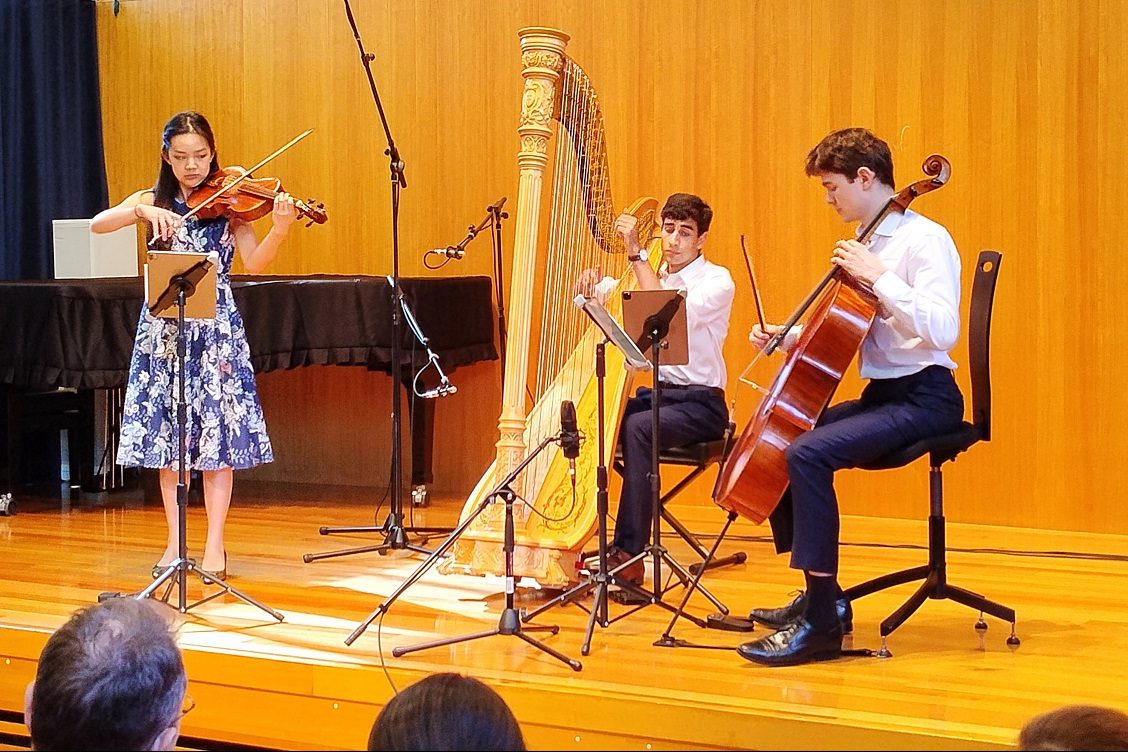A ONE-hour concert dedicated to contemporary women composers, was held in the National Portrait Gallery during an exhibition of female visual artists. Why then, was half of that allocated time devoted to major works by male composers? It beggars belief.
The two major works by men were Don Banks’s Herculean “Sequence for Solo Cello” and Carl Vine’s “Strutt Sonata for Cello and Piano”. Let’s talk about them first.
Banks’ “Sequence” is a sophisticated lexicon of extended performance techniques for strings. Soloist Julian Smiles conjured an extraordinary array of colours from his 1827 Lorenzo Ventapane Cello – sul ponticello, sul tasto, battuto, col legno battuto. Banks’ work is elegantly crafted from overlain left-hand pizzicato and bowed textured, from serialistic tritone sonorities and pointillistic utterances. It is a modern masterpiece by anyone’s estimation, and it overshadowed this concert like a great mountain.
Vine’s “Strutt Sonata”, equally challenging if not as accomplished as the Banks, highlighted the virtuosity of pianist Bernadette Harvey. This lengthy and showy work was commissioned to honour the “dedicated and enthusiastic patrons of the Huntington Estate Music Festival”, which the composer has directed since 2006. “Strutt Sonata” canvasses tropes from late modernism. Piano and cello explode in quasi cadenzas and outbursts of Reichian rhythmic modulations. It took pride of place, at the concert’s end, like a fireworks display.

Between these masculine monoliths, three bright lights shone out. Miriam Hyde’s highly accomplished “Sonata in B minor for viola and piano” (arranged for cello and piano), Ella Macens’ understated “Oh Sister for cello and piano”, and Leanne Bear’s beautiful new work “Art Nouveau”.
Hyde’s 1937 sonata is an elegant pastoral work – late-romantic, bordering on early modern. Smiles brought lyricism and beauty of tone production to expansive cello lines. The piano came to life with subtle textural shifts and Harvey’s lightness of touch. The success of Cyrus Meurant’s new arrangement of the viola part for cello was partly due to the close sense of ensemble between the players.
Miriam Hyde was a light in the darkness for generations of forgotten women composers – a symbol of a new dawn coming. But that dawn has evidently not arrived. In a one-hour program, less than 20 minutes was given to contemporary women composers – contemporary in the sense of being still alive, writing in this century.
Macens’s “Oh Sister” is a touching tribute to a sibling suffering Lyme disease. An arpeggiated piano part is coupled with sweeping cello lines, subtly shaded with double stops and long pianissimo notes. Originally written as part of the National Women Composers’ Development Program in 2016, this is a very fine work from a fledgling composer – nuanced and sensitive. I hope she is supported and nurtured in her development.
Bear’s ‘Art Nouveau’ was the only major work by a contemporary woman composer in this program. Inspired by Elizabeth Hickey’s fictionalised biography of Gustav Klimt, “The Painted Kiss”, “Art Nouveau” is a rhapsodic fantasia rooted in solid compositional craft.
Bear combines freely atonal language with references to past music – always seamlessly, without ever becoming sentimental or overblown. She evokes the Viennese Secession with interwoven lines, shimmering like the golden tapestry threads of a Klimt painting. Piano and cello become figures melting into one another – “The Kiss”, made manifest in sound.
Bear’s beautiful tone poem is a work of carefully crafted dissonances and white space. It is the work of a major composer, a contemporary woman artist who is genuinely “making Australian history”.
I hope a day comes when we can celebrate artists such as Leanne Bear and Ella Macens, women composers, without having to program them alongside louder, more famous men.
Who can be trusted?
In a world of spin and confusion, there’s never been a more important time to support independent journalism in Canberra.
If you trust our work online and want to enforce the power of independent voices, I invite you to make a small contribution.
Every dollar of support is invested back into our journalism to help keep citynews.com.au strong and free.
Thank you,
Ian Meikle, editor




Leave a Reply